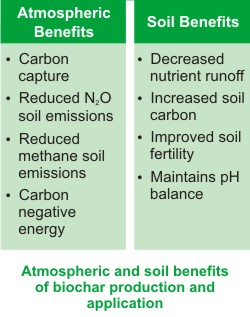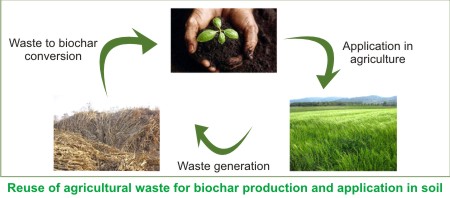|
Agricultural Waste Potential in Boosting Circular Economy
With
an annual generation of 350 million tonnes of organic waste from
agricultural sources, India is the second largest producer of paddy
after China (Pappu et al., 2007). Only half of the paddy and straw
generated is being used as fodder and the rest remains unutilised. Every
year, farmers in Northwest states, Punjab and Haryana, practice stubble
burning in their agricultural fields post-harvesting. The crop residue
burning generates particulate matter and gases such as carbon dioxide,
carbon monoxide, nitrous oxide, methane deteriorating the air quality
and creating smog as a result of air-gas-particulate mixing. Efforts
made to address this challenge include use of agricultural waste
materials for energy generation in bio-refineries, briquetting of
biomass and use as energy source. More efforts to address this problem
on Converting Agricultural Waste into Carbon-Rich ‘Biochar’ Thermochemical conversion of agricultural waste into carbonaceous material called ‘biochar’ is a sustainable approach towards climate change mitigation and circular economy (Bruckman, 2015). Biochar is a porous carbon rich material with surface properties very close to commercial activated carbons. Biochar is produced by heating the dry lignocellulosic agricultural waste in the absence or limited supply of oxygen in a specially designed reactor. The thermochemical process followed for biochar production is known as pyrolysis. The black carbon rich biochar thus obtained can be utilised for a variety of applications in soil and water. For agricultural soils, biochar can be applied as a conditioner for enhancing crop productivity, raising water holding capacity, soil porosity, essential nutrients availability and microbial respiration. Worldwide, biochar practitioners have tested the potential of biochar for a variety of crops and measured a considerable increment in total crop production after biochar addition to the soil. Biochar and Climate Change The application of biochar in soil is a carbon negative practice. The biochar when applied to agricultural soils can stay for hundreds of years because the carbon present in biochar resists to degradation. The result is a net CO2 reduction from the atmosphere. Converting agricultural waste into biochar can therefore avoid methane and CO2 emissions that could have emitted as a result of stubble burning or natural decomposition. Biochar application to soil also reduces nitrous oxide emissions from agricultural soils, one of the potent greenhouse gases. There is a significant increase in soil microbial life. This will ultimately result in more carbon storage in soil. The biochar application adds value to crop residues and by-products and addresses climate change issue by sequestering carbon.
Initiatives for Global Recognition The International Biochar Initiative (IBI) has brought together companies, organisations and biochar practitioners on a common platform. Their objective is to foster stakeholder collaboration, good industry practices, environmental and ethical standards that can support safe and economically viable biochar systems. Additionally, the IBI disseminates biochar standards, research tools, knowledge materials including recent advancements in terms of technology. IBI certifies biochar products for research institutions, organisations and biochar industries. ■
Dr. Ankur Sarswat References
|
 agricultural waste management is the need of the day.
agricultural waste management is the need of the day. 